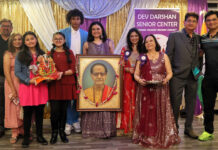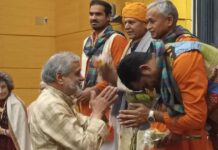
CHICAGO: Chicago Samskriti Foundation hosted “Rasaanubhavam: an interactive exploration of Raga, Rasa and Rhythm,” conceptualized by SF’s founder-director Shoba Natarajan within its “Anubhava” (experience) series of workshops, here at Madden Theater, April 26.
Presenters were Sanskritist scholar Maragatham Sundaresan, percussionist Vinod Gopinath, musician-vocalist Chitravina Ravikiran and Bharat Natyam danseuse Sudha Chandrasekhar. They spoke respectively on the Indian notion and pursuit of aesthetic ‘taste’ (rasa), generated by melodic structure (raga), rhythm (tala), and visual expression (abhinaya), coming together finally in a spontaneous ensemble.
Sundaresan commented on rasa chapter of Natya Shastra, foundational treatise on the elements and principles of Indian theater. The performance revolves around evoking and sustaining (aesthetic) ‘sentiment’ (rasa), traditionally eight with tranquillity added later.
She illustrated through ‘humor’ (hasya-rasa), describing its causes, psychophysical effects and accompanying transitory mental states. Inferior characters are more prone to uncontrolled laughter.
Chandrasekhar’s students, Mallika Sarma and Ashwaty Chennat, demonstrated its six grades. Hasya, as a subsidiary, even trivial rasa difficult to distinguish from the laughter reflex, may not be the best choice to illustrate.
Gopinath demonstrated the three dimensions of rhythm, namely speed (tempo), flow (nadai) and repetitive cycles (talam). Speed is typically tracked in multiples of 2 and helps reflect emotional state. Of the different nadais (tisram, catusram, etc.), he showed how sankeerna nadai of nine beats (5+4) could evoke the tranquil gait of an elephant, and khandam anger as in the vigorous dance (tandava) of Shiva.
He started with the most common talam, the eight-beat Aadi, which remains constant irrespective of the tempo of the music. The 35 talams, which define “paragraph length,” can be executed in different nadais.
Gopinath also touched upon the more complex talams based on a non-integral number of beats (2.5, 3.5, etc.). Though rhythm may reinforce the pertinent emotion, percussion in its supportive role must match the pace of music and dance, which generate rasa more directly.
Ravikiran observed that whereas the modes of medieval western music resembled ragas, everything has now been reduced to harmony in major and minor scales. The formulaic permutation and sequence of notes in Indian ragas make all the difference. Shankarabharanam, equivalent of major scale, is considered cheerful.
Minor notes are exploited for melancholy: Shubapantuvaraali (Hindustani Todi), for example, exudes such sadness that it is typically heard on All India Radio upon demise of a great personage. Whereas gliding (meend) between notes is central to Hindustani ornamentation (gamaka), oscillation (kampitam) unique to Carnatic music opens up richer possibilities of emotional nuance: the singer may be saying “ma” without actually touching this fourth, what happens between and around notes is more important than the actual frequency of the note.
This child-prodigy, who amazed scholarly connoisseurs at age 2 through effortless recognition of ragas, took listeners through a fascinating exploration of their subtleties, how substitution or varied handling of a note could transform its emotional coloring. Conversely, distinctions between proximate ragas, e.g., Shree and Madhyamaavati, must be maintained.
Whether to render a raga only briefly to provide contrast or to develop it at length, depends on the rasa the musician wants to evoke that day. Voice culture is more mental than physical: listening to masters until the raga becomes instinctive is critical.
Sudha Chandrasekhar, almost 75, from Michigan mentioned the four kinds of abhinaya. As Sarma and Chennat did an invocatory dance to Ganesha, she indicated the symbolic gestures (mudra) depicting trunk, etc. that evoke wonder at a chubby child cavorting. Storytelling thus becomes compelling.
Unprepared, she had children act out love at first sight in “who verily could she be?” (Yaaro Ivar Yaaro in ragam Bhairavi), boys playing Rama, girls Sita, which became a hilarious (hasya) workshop indeed.
To illustrate how lyrics, raga, tala and abhinaya could combine spontaneously to generate the experience of rasa, Sundaresan composed an extempore verse that described the arrival of spring in Chicago. As Ravikiran sang the words in ragam Bilahari to Gopinath’s Aadi talam, Chandrasekhar mimed the scenery and exhilarating mood.
They were asked to explain their choices, the creative process itself, by the lovers of Indian culture and connoisseurs enjoying the rasa, those present being described in the Sanskrit verse itself.
Elizabeth Visuvalingam






